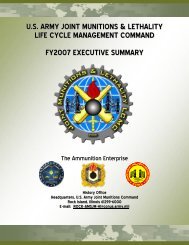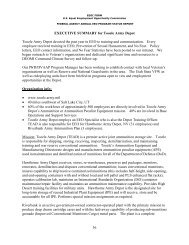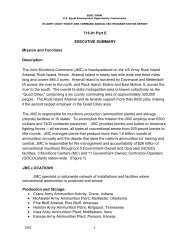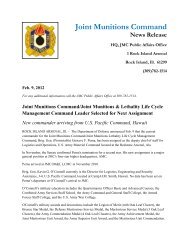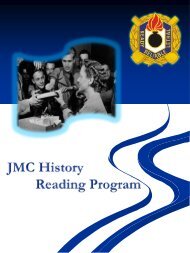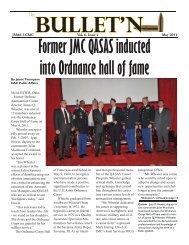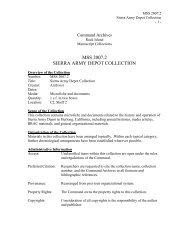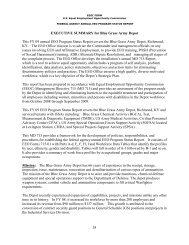History of the Ammunition Industrial Base - JMC - U.S. Army
History of the Ammunition Industrial Base - JMC - U.S. Army
History of the Ammunition Industrial Base - JMC - U.S. Army
Create successful ePaper yourself
Turn your PDF publications into a flip-book with our unique Google optimized e-Paper software.
<strong>History</strong> <strong>of</strong> <strong>the</strong> <strong>Ammunition</strong> <strong>Industrial</strong> <strong>Base</strong><br />
From Creation to Present Day<br />
<strong>Ammunition</strong> is a unique commodity that requires technical production accuracy to exact<br />
specifications and superior quality levels for <strong>the</strong> safety <strong>of</strong> its users. To accomplish this mission a<br />
network <strong>of</strong> government owned contractor operated (GOCO) and government owned government<br />
operated (GOGO) ammunition industrial sites has evolved over time to produce superior<br />
munitions for all U.S. military Services and Allies. The U.S. <strong>Army</strong> ammunition industrial base<br />
has experienced great degrees <strong>of</strong> transformation over <strong>the</strong> past half century. The base has<br />
experienced <strong>the</strong> largest <strong>of</strong> expansions during World War II (WWII) to <strong>the</strong> lowest levels <strong>of</strong><br />
reduction during <strong>the</strong> current Global War on Terrorism (GWOT) 1 , now referred to as Overseas<br />
Contingency Operations (OCO). Reasons for <strong>the</strong> reduction include factors such as<br />
modernization <strong>of</strong> production technology and more peaceful periods <strong>of</strong> history. The following<br />
history examines <strong>the</strong> evolution <strong>of</strong> <strong>the</strong> industrial base, emphasizing <strong>the</strong> changes and provides<br />
rationale for <strong>the</strong> gradual decrease in <strong>the</strong> size <strong>of</strong> <strong>the</strong> ammunition industrial base from WWII to<br />
2010. This report addresses specific challenges in regards to right-sizing <strong>the</strong> industrial base,<br />
which leads to <strong>the</strong> frequently debated question: what should <strong>the</strong> ammunition industrial base look<br />
like for <strong>the</strong> future?<br />
The ammunition industrial base is a complex system composed <strong>of</strong> contractors,<br />
subcontractors, government owned and government operated (GOGO), and government owned<br />
and contractor operated (GOCO) facilities. The government owns key facilities to manufacture<br />
propellants and explosives and to load, assemble and pack (LAP) munitions with contractors<br />
operating most <strong>of</strong> <strong>the</strong> facilities and operations.<br />
The current munitions base evolved from <strong>the</strong> large base established to meet <strong>the</strong> demands<br />
<strong>of</strong> WWII. The base evolved to meet <strong>the</strong> Korean Conflict, Vietnam Conflict, Cold War tensions,<br />
and ongoing conflicts in <strong>the</strong> Middle East. The base has been reconfigured several times to meet<br />
projected requirements, to accommodate changing weapons technology, and to incorporate<br />
improved manufacturing methods. The challenge for managers <strong>of</strong> <strong>the</strong> conventional ammunition<br />
base is to create <strong>the</strong> proper balance between two competing needs - <strong>the</strong> need to maintain <strong>the</strong><br />
reserve capacity required to replenish <strong>the</strong> war reserves after a major conflict and <strong>the</strong> need to<br />
economically meet peacetime requirements. To fully understand <strong>the</strong> situation and state <strong>of</strong> <strong>the</strong><br />
current ammunition industrial base, a closer look at its origins and evolution is necessary.<br />
The Ordnance Department (OD)<br />
The Revolutionary War taught <strong>the</strong> Nation its first lessons in material mobilization.<br />
Successful war conduct was linked to <strong>the</strong> availability <strong>of</strong> war-fighting supplies and equipment.<br />
The leaders <strong>of</strong> <strong>the</strong> Continental <strong>Army</strong> realized that efforts were needed to organize, produce,<br />
manage, and supply <strong>the</strong> Nation‟s <strong>Army</strong> if it were going to gain independence and win <strong>the</strong> War<br />
against England. In November 1775, Colonel Henry Knox established one <strong>of</strong> <strong>the</strong> firs U.S.<br />
industrial base capabilities. He selected Carlisle, Pennsylvania as <strong>the</strong> site for <strong>the</strong> first<br />
Continental <strong>Army</strong> Depot Arsenal. Carlisle, along with approximately 27 o<strong>the</strong>r depots and<br />
arsenals, stored and maintained supplies for <strong>the</strong> Continental <strong>Army</strong> during <strong>the</strong> Revolutionary War.<br />
1<br />
GWOT is now referred to as Operation Enduring Freedom (OEF), Operation Iraqi Freedom (OIF), and Operation<br />
New Dawn or Overseas Contingency Operations (OCO).<br />
3



